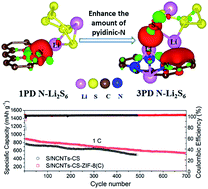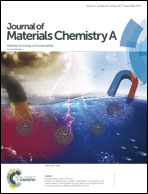Immobilization of sulfur by constructing three-dimensional nitrogen rich carbons for long life lithium–sulfur batteries†
Abstract
Lithium–sulfur (Li–S) batteries have been considered as next-generation rechargeable energy storage systems due to their high theoretical energy densities and low cost; however, the capacity decay resulting from the shuttle of lithium polysulfides (LiPSs) hinders their practical application. Herein, we describe a strategy to synthesize highly pyridinic-N-doped three-dimensional (3D) carbons for the chemisorption of LiPSs, which consist of zeolitic imidazolate framework-8-derived carbon (ZIF-8(C)) coated on the surface of N-doped carbon nanotubes supported by carbon nanosheets (NCNTs–CS–ZIF-8(C)). Using the obtained carbons as sulfur hosts, the S/NCNTs–CS–ZIF-8(C) cathodes show a high sulfur utilization of 86% at 0.1 C, a low capacity decay rate of 0.052% per cycle over 700 cycles at 1 C and impressive cycling life that is 564 mA h g−1 after 700 cycles at 1 C. First principles calculations based on the Vienna Ab-Initio Simulation Package (VASP) reveal that increasing the amount of the pyridinic-N component can enhance the adsorption of LiPSs, which yields effective suppression of the LiPS shuttle.



 Please wait while we load your content...
Please wait while we load your content...